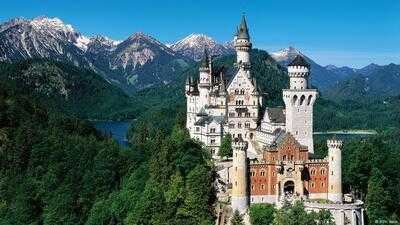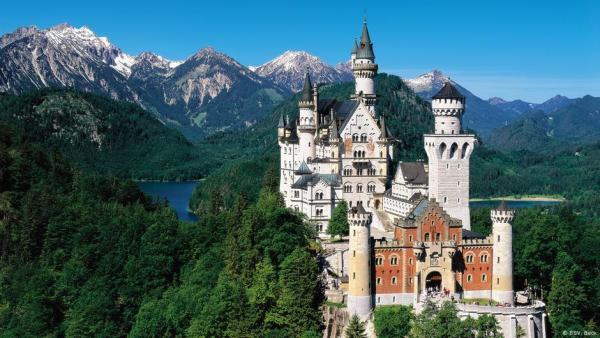

A fairytale-like castle, a sunken port city in the Caribbean, and mysterious cave paintings: Which of these places will be named as the latest entries to the UNESCO World Heritage Site list?In just a few days, the palaces of King Ludwig II of Bavaria could be added to the UNESCO World Heritage Site list. Alongside 31 other sights around the world, Neuschwanstein Castle, Linderhof Palace, the King's House on Schachen, and the Herrenchiemsee palace complex have been nominated for inclusion. Decisions will be made at the 47th session of the World Heritage Committee in Paris (which ends on 16 July 2025). For ten years now, King Ludwig II's Bavarian palaces have been at the top of Germany's wish list for new additions. Perched high above the edge of the Alps, Neuschwanstein Castle is one of Germany's most famous buildings. With its many towers, it looks like something out of a fairy tale. This "dream in stone” draws more than 1 million visitors from across the globe every year. Commissioned by King Ludwig II of Bavaria (1845-1886), construction on Neuschwanstein castle began in 1869. Originally intended as a private residence for the king, it was never completed. This picturesque palace owned by the federal state of Bavaria is also famous for its pompous interior design. Many German World Heritage Sites From Aachen Cathedral to the Zollverein Coal Mine Industrial Complex, there have already been more than 50 German World Heritage Sites listed since the 1970s, when UNESCO passed the World Heritage Convention. The catalyst at the time was the loss of cultural artifacts during World War II. However, the decisive factor was the construction of the Aswan High Dam by the Egyptian government in the 1960s, which would have flooded the world-famous temples of Abu Simbel. The agreement, which around 195 countries have ratified, is tasked with protecting cultural and natural sights of universal value. Currently, there are 1,223 World Heritage Sites, of which 952 are cultural heritage and 231 are natural heritage. The World Heritage Committee's perspective extends far beyond Germany. This year, a total of 32 cultural landmarks from countries across the globe have been nominated, including: the ancient Khuttal region in Tajikistan, the Caribbean underwater city Port Royal in Jamaica, the modernist center of Gdynia in Poland and the memorial sites for the victims of the Khmer Rouge in Cambodia. Indian Fortresses soon to be World Heritage Sites? India has nominated an ensemble of ancient fortresses to be World Heritage Sites. These impressive castles, located in the states of Maharashtra and Tamil Nadu, represent the military power of the Maratha Empire, which controlled large parts of the Indian subcontinent from the 17th to the 19th century. Amongst other sites, the United Arab Emirates have nominated the Faya Palaeolandscape as a remarkable example of a Stone Age desert landscape. South Korea submitted the Daegokcheon Stream Petroglyphs, which are mysterious pre-historic rock engravings. Russia opted for the rock paintings in the Shulgan-Tash Cave in the southern Ural Mountains, which are more than 20,000 years old. And China submitted the Western Xia Imperial Tombs, an example of cultural heritage from the Tangut civilization and one of the largest necropolises in the world. The UNESCO World Heritage Site list currently includes 1,223 cultural and natural heritage sites in 168 countries, 56 of which are at risk of being destroyed. The worldwide ranking has been met with widespread criticism, especially in scientific circles. As Christoph Brumann from the Max-Planck-Institute for Social Anthropology in Halle puts it, "How objective can this type of ranking ever be?” UNESCO Ranking Faces Criticism Anthropologist and world heritage expert Brumann has questioned the decision-making process by citing his research into the consequences of World Heritage Site designation for the affected regions. The most common effect is mass tourism. "The local population could profit from this, but often times, the negative consequences far outweigh the positive ones,” Brumann is quoted in the MaxPlanckResearch science magazine. His book "The Best We Share: Nation, Culture and World-Making in the UNESCO World Heritage Arena” was published in 2021. The World Heritage Committee, comprised of elected representatives from the 21 member states of the World Heritage Convention, will also discuss in Paris the growing threat to existing World Heritage Sites. Such as threats coming from armed conflicts in Ukraine and the Middle East, or from natural disasters, environmental pollution, poaching or uncontrolled tourism. According to a recent study by UNESCO and the World Resources Institute, water scarcity and flooding currently pose major threats to almost three quarters of all World Heritage Sites. One in five landmarks is stuck in a cycle of water scarcity and flooding. This includes the Taj Mahal in India, which is at risk of sinking due to a drop in groundwater level. After massive flooding in 2022, Yellowstone National Park in the US had to be closed. According to reports, rebuilding the infrastructure would cost more than $20 million (€17 million). The most affected regions are the Middle East, North Africa, parts of South Asia, and northern China. Meanwhile back at Neuschwanstein Castle in Bavaria, the decisions made in Paris are eagerly being awaited. If the palace is recognized as a World Heritage Site, it will probably draw even more tourists. What the Bavarian Administration of Palaces may find more important, however, is the worldwide recognition that would come with the award. This article was originally written in German.
-
Scientists also shocked this truth related to the vagina of women – sensational disclosure in research

-
Know these important things before drinking vine juice in summer! Otherwise there may be loss

-
Hair transplants: The rising trend and how safe they really are

-
Who are the Kawariyas? Kawad Yatra history and meaning

-
Seasonal diseases are in danger in the rain, drink medicinal properties for prevention
